The Story of Wavendon Tower
The building known as Wavendon Tower now sits at the centre of a business park complex just west of Wavendon. It was not always so closely confined and once sat on its own small rural estate. It has had a relatively short history, but during its 135-year presence, it has seen use as propaganda recording studios for the Second World War and as a base for the Development Corporation which built the ‘new city’ of Milton Keynes.
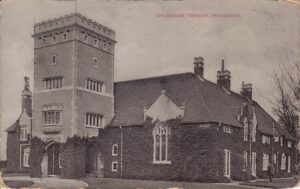
The Burney Family, 1890-1936
Rev. Henry Burney B.A. was curate at Whatley Rectory, near Frome, Somerset, when he was given the position of vicar at Wavendon by Henry Charles Hoare, Esq., then owner of Wavendon House and member of the Hoare & Co. banking dynasty. In January 1847, Rev. Burney took up the vacancy created by the death of Rev. John Fisher, the last incumbent. Rev. Burney remained at Wavendon as vicar for 47 years. His appointment to the village was no doubt connected to the fact that that he had married one Sophia Hoare, a cousin of Henry Charles, in 1842. Their only son, Henry Edward Burney, arrived in 1845, followed by several daughters. Thus Henry Edward Burney came to Wavendon when he was aged about two.
The 1851 census shows the family at home in the old Wavendon Rectory, with 5-year-old Henry Edward described as a scholar. Also in the house were three members of the Hoare family – Sophia’s mother and two sisters – and four servants. In 1858, Rev. Burney had the old Rectory demolished and a new version built, where they were in residence for the 1861 census. This also shows the 15-year-old Henry Edward as a scholar at home with his father, but his mother was not in the house that night. His sister, a cousin and four servants were recorded too. A later biography says Henry Edward was educated at Radley College, Oxfordshire.
In 1865, aged 20, he became a probationary bank clerk at his mother’s family firm, at an initial salary of £200 per annum. Hoare’s is a British private bank, founded in 1672 by Sir Richard Hoare, and is currently (2023) owned and led by the eleventh generation of his direct descendants. It is the second oldest bank in the United Kingdom and reputedly the fifth oldest in the world. In parallel with his work life, at the age of 22, Henry was appointed as a Lieutenant in the Royal Bucks King’s Own Militia. This Battalion was a voluntary reserve one, training local men in their evenings and weekends, with a months’ training on manoeuvres every year to practice their military skills in case they were needed in time of war. In 1876, it comprised of 699 men and 21 officers.
For the next census in 1871, he appears at no.35 Fleet Street, London, in a household of nine bankers’ clerks. This was the staff quarters for Hoare & Co.’s, located next door to the main bank. The bank’s archivist believes he was probably brought in to learn the business with a view to becoming a Confidential Clerk. Sometimes referred to as ‘Agents’, these were members of the family who naturally held higher status than the regular clerks but had no share in the business – i.e. they were employees rather than partners. They would have been trained in all the various aspects of banking, but also had the higher responsibility of ‘Sleeping Duty,’ which meant they were on-hand if there was some sort of security crisis overnight.
Henry’s mother died in 1872, whilst in Tunbridge Wells, after ‘…many years of failing health, and much suffering’, according to the Maidstone Journal of 30th September.
Henry was married in Switzerland in May 1872, to Ortensia, the elder daughter and heiress of Count Asclepi Troili, an officer of the Papal Guard of the Palazzo Odescaichi in Rome. At home again, he was promoted to a Captain in his Battalion in August 1873. The 1880 Post Office Directory lists him at no.13 Bryanston Street, not far from Marble Arch, but the next census of 1881 shows him staying the night back at the staff house for Hoare & Co. in Fleet Street again. Living with nine other bank staff and seven maids, he chose to give his profession as “Captain, Royal Bucks K.[ing’s] O.[wn] Militia”.
Hoare’s Bank published their own history – “Hoare’s Bank: A Record” in 1955. It contains this description of a clerk’s daily life who had started there in 1863. I doubt it had changed very much over the next 20 years:
“There was no going out but half an hour was allowed for the Luncheon which was provided in the clerks dining room on the first floor. Discipline was very strict and you were kept hard at work the whole day because there was a certain amount to be done and it had to be completed by the junior Clerks before dinner time at 5p.m. or they had to resume their labours after 6 when dinner was supposed to be over so far as they were concerned. The dinner, which was of a very substantial character, was served every day punctually at 5 o’clock when the Bank doors were closed to the Public and was usually attended by the whole Staff except two men who were on the Balance, and one Junior whose duty it was to copy the letters by hand and take them to the post. These three had their dinner in the middle of the day.
The Chair was taken by the Senior Clerk, a little old man with quite white hair named Thomas Lee. He entered the House in 1812 and occupied the seat of chief cashier until his death in 1866 at considerably over 80 years of age. The Vice Chair was occupied by the Junior as all the clerks sat at the table in strict order of seniority. Four bottles of wine were supplied each day, 2 of sherry and 2 of port, and before you tasted your wine it was the strict rule that you should drink the health of your colleagues and the Chairman in the following formula “Mr. Chairman, your very good health Sir, Gentlemen, all your good health”. The old chairman always responded by raising his glass and nodding his head. I well recollect my surprise and confusion on the first occasion of my sitting at the bottom of the table when I was told that the Chairman was about to drink my health. This he did in these terms. “Mr. Tilden, Sir, your good health. Glad to see you, Sir.” He invariably addressed the Juniors as ‘Sir’, I presume in order to keep them at a respectful distance. Two of the Porters waited at table and if the Balance was agreed before the dinner was over one of the Porters from downstairs was sent up to make the announcement, “Gentlemen, the Balance is right”, and always received from the Chairman a glass of wine for his pains.”
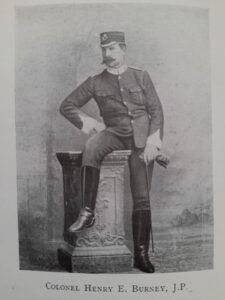
Henry was certainly regularly in Wavendon too, as he sung in a concert at the schoolrooms there on 25th April 1881, performing the songs The Minute Gun at Sea with a Mr. Routledge and soloing on The Captain and his Whiskers. (See picture – how appropriate!) He then became a Major in the 3rd Battalion Oxford Light Infantry (as the Bucks. Militia had been renamed) in June 1882 and his name was included on the commemorative stone when new barracks were built for them at High Wycombe in 1883.
Here, we finally get down to the history of Wavendon Tower. From the North Bucks Times & County Observer, 5th April 1890:
“WAVENDON. Major Burney, son of the Rev. H. Burney, the vicar of Wavendon, is about to erect a mansion at Wavendon of stately proportions. It is to be called Wavendon Towers, and will grace an already picturesque neighbourhood. Mr. Charles Granville Barker, of 5, Bloomsbury Square, London, is the architect, and the builder is Mr. S. Foster, of Bedford, the price being £4,805.”
In assembling the land required, he had bought up fields in the parishes of Wavendon, Walton and Milton Keynes (when it was just a tiny village). The North Bucks Times again, 28th June 1890:
“WAVENDON. “THE WAVENDON TOWERS.” (The future seat of Lieut.-Col. Burney) Some forty years ago or more the Rev. Henry Burney succeeded to and happily still enjoys the living of St. Mary’s, Wavendon. At that time considerable interest was roused by the rev. gentlemen building the present rectory house, a mansion of local sand-stone, in the early Gothic style, at a cost exceeding £3,000 and designing and planting the charming grounds in which the building stands. The two pretty cottages on the carriage way to the rectory approached through gardens of sweet flowers form a pretty a country picture as may be conceived, are also improvements by the rector. To-day the great event of the locality is the building of a mansion by Lieutenant Colonel Burney, the only son of the rector. It is but a few years ago he purchase the lands of the late Mr. Thos. Gadsden, situated on the west side of Wavendon, and it is now on the entry of the village from the Walton road that a handsome structure is being erected.
To fifteen acres, a portion of the Gadsden Estate, Colonel Burney, through his agent, Mr. Whitman, of Aspley, has purchased thirteen acres, or thereabouts, of the immediately adjoining Battam estate, four acres of Geo. Henry Finch, Esq., and about nine acres of Mrs. King, widow of the late Mr. Thos. King, maltster, and upon which stand more than one hundred young elm trees. The mansion and grounds it is calculated consists of forty-one acres, about, commanding the most lovely and expanded views over Brickhill and Aspley Woods, Woburn, Cranfield, Moulsoe, Newport, Hanslope, &c., &c. The “Wavendon Towers” will be in touch of the Rectory and the beautiful church in the sacred precincts of which many loved ones of the Burney family rest, whose good works were corner stones.
It will be, for a modern dwelling, of a somewhat uncommon plan, with a court yard in the centre. The total area of ground the house now actually covers is 8502 superficial square feet. There are to be six reception rooms and twelve bed rooms, kitchens &c, with all other requisite domestic offices. The salient features in the block will be a late Tudor tower over the main entrance, 50 feet in height and 18 feet square. The consists of three bold archways, which will be admirably adapted for a porch, the upper part being used for a study, bed-room, and a box-room. There will be an oriel from study, and the other rooms will have windows on all sides. The tower is shown to have a richly moulded stone cornice, relieved with stone panels, spaced at regular distances for carvings, and terminating with a battlemented parapet in stone. The external face of the walls, including the tower, will be rendered in neat Portland cement, and finished with “rough cast” of a pale stone colour; the facings to courtyard will be of thin dark red sand bricks, laid in “old English bond”; the chimney-stacks above roof line will also be red sand bricks, with castellated caps and nickings to harmonise with top of tower.
There are two kinds of stone being used, viz., “Doulting” and “Weldon,” the former is for copings, parapets, chimney caps, and such other parts exposed to the weather; the latter for quoins and dressings to the flat windows. The roofs will be covered with small local dark red tiles. The windows throughout will be in casements and hung to open outwards, glazed with glass in lead. French casements will be provided for drawing-room, morning-room, and billiard-room.
The building throughout will be well ventilated with warm air, and heated with hot water. The architect has bestowed special attention to the drainage and sanitary arrangements. The foul drain will be laid outside the building, and in no instance will any pass under the building. The drains will be intersected at three different points with manholes and chambers; there will be fresh air inlets and foul air outlets. The sewage tank will be placed at a distance of about 180 yards from the building. A rain water tank is placed in the courtyard; adjoining the tank are two filter beds, through which the water passes before entering the tank. The hard water supply will be pumped up daily from the well into a huge tank to be especially constructed in the roof. Hot and cold-water supplies will be laid on to the baths, lavatories, and sinks. The works are being satisfactorily carried out by Mr. Samuel Foster, of Kempston, and his able foreman, Mr. Tomlin and under the superintendence of the architect, Mr. C. Granville Baker, Bloomsbury Square, London.
Wavendon has of late years greatly improved, the purchase of many dilapidated cottages by Colonel Burney, thoroughly repaired and cleansed, have made for the villagers wholesome homes; the agricultural labourer has advanced in common sense, feeling and intelligence, they are not influenced by brawling leaders; at the public meetings’ of the day they have become good listeners, the noisy yelling and the tumults and din is no more. At the late Odd Fellows Festival, when Mr. Hoare, of Wavendon house, presided, supported by Mr. N. Sturges, Colonel Burney, Mr. Sterry, Wavendon Lodge, Sir William Clayton and others, the strictest order prevailed – all good conservatives jealous of the welfare and comfort of those around them. The enterprise of Colonel Burney has done much for labour, all are employed in the village, and lodgings fully occupied. Mr. Thos. King, so well acquainted with the land of the district, has fallen in for the measuring of the newly attached acres to the Wavendon Towers.”
The building of his new home coincided with his relinquishing his banking job. Hoare’s Bank sent Henry a letter in September 1890 when he resigned:
“We have agreed to your retirement and in consideration of various circumstances have determined to make you an allowance of Eight hundred pounds to be paid by quarterly installments of £200. The first installment to be made at Xmas 1890. It is understood that the allowance is voluntary and continued at the pleasure of the Firm.”
Burney and his family had already moved out of central London, but not straight to Wavendon – they had relocated to Surrey, where they were still living in 1891 whilst Towers was being finished. They lived at “Coombe Leigh”, on London Road (now the A308) near Kingston. They had had a son, Guy Henry Chetham Pompeo Burney, and lived with five servants. Meanwhile at Wavendon, an entry for “The Towers” had been crammed in above the first line of the census of that year, but marked as an Uninhabited Building.
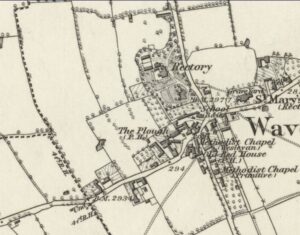
Above, the OS map of 1880, and below, the same from 1898, showing the arrival of Wavendon Tower. The fields west, east and north of the house were all part of the Tower estate.
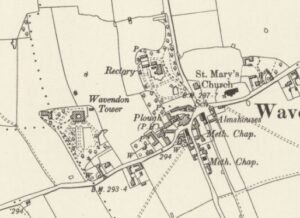
![Building News' article, 1891 [British Newspaper Archives]](https://www.mkheritage.org.uk/wsc/wp-content/uploads/sites/17/2025/10/BN-1891a-300x177.jpg)
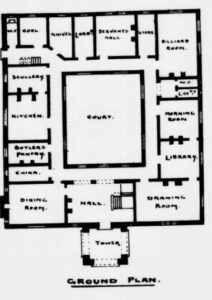
Having achieved his successful banking career, military command and building a thoroughly modern house, he next set about becoming an important figure in the local community, being appointed as a J.P. for Bucks. This enabled him to sit on the local Magistrate’s bench and make legal decisions. He was confirmed as a J.P. in July 1892 and thereafter appears regularly in newspaper reports, adjudicating on local petty crimes and licensing matters etc.
His father, the Rev. Henry Burney, died in 1893, of pneumonia, aged 79. He had performed a wedding at Wavendon on 11th July, but was taken ill shortly afterwards and died less than a week later. He had collected an astonishing number of butterflies and moths as a hobby, including 18 examples of the Great Copper butterfly, thought extinct since 1851. His collection was sold at Covent Garden and the Great Copper examples alone made £79. The gothic rectory he had lived in since having it built in 1858 was later the home of Cleo Laine and Johnny Dankworth. He had served as Vicar at Wavendon for 47 years. The next vicar, Rev. Barrington Henry Arthur Philpotts, served for 54 years, meaning that Wavendon only had two vicars covering an entire century.
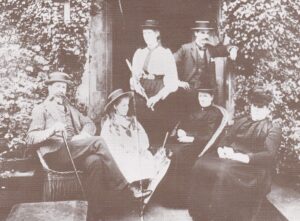
The August 1895 Parish magazine for the district records:
“Thursday, the 18th was chosen for the annual treat to all the children of Wavendon-cum-Walton, attending the Day School. At 4, the children marched from the school to the grounds of the Towers, where Col. Burney was waiting to receive his young friends. After a good tea on the lawn, races and sports were indulged in for prizes until 8 o’clock, when a heavy shower put an end to the proceedings. Hearty cheers were given for the Col. and Miss Burney, Mrs. Philpots and Mr. and Mrs. Buxton. Our best thanks are due to the many kind friends who helped to amuse and entertain the youngsters.”
His Lieutenant-Colonel rank was presented in July 1897, the same year as a large garden fete, bazaar and bicycle gymkhana took place in Wavendon Tower grounds in August for the Wavendon Church Institute Building Fund.
![From Wavendon Parish Magazine, August 1897 [Authors collection]](https://www.mkheritage.org.uk/wsc/wp-content/uploads/sites/17/2025/10/1897-300x255.jpg)
Col. Burney was photographed (see top of page for photo) and described in the book Buckinghamshire Leaders, by C. A. Manning Press, in 1905:
“A prominent and interesting personality in the county of Buckingham is Colonel Henry Edward Burney J.P., who has had a very creditable and successful military career, and enjoys to a singular degree, the respect and regard of all with whom either private or official business might bring him into contact. He is, indeed, a fine combination of an English soldier and an English gentleman.
The gallant Colonel holds very decided views on military matters. A believer in kindness, he is nevertheless a strong advocate of strict discipline, which he considers, and very truly too, to be absolutely necessary in dealing with large bodies of men. He is an earnest advocate of drastic reforms of the War Office – reforms which are now happily being vigorously carried out.
He was Lieutenant-Colonel Commanding of 3rd Battalion Oxfordshire Light Infantry, and proved himself a most efficient and popular officer. Frank, fearless and firm, he is always ready to deal fairly and considerately with everybody, and this largely explains the genuine esteem in which he is widely held.
In politics, an Independent, Colonel Burney values fully a firm and wise Imperial policy, the consolidation of the Empire, and the protection of the liberties of Englishmen at home and abroad. Hunting and shooting are his favourite pastimes, and probably he is rarely happier than when enjoying to the full one or other of these delightful recreations. Colonel Burney was born in London, educated at Radley, and married Ortensia, elder daughter and heiress of Count Asclepi Troili of Rome, and has issue one son, Guy Henry Chetham Pompeo Burney. His Buckinghamshire residence is Wavendon Tower.”
The 1911 census is the last with the Burney’s at Wavendon. Now 65 and his wife 62, they are there with their son Guy, 37. Under occupation, they have all entered ‘None’. They had one Parlourmaid and one Housemaid. A book, “Buckinghamshire; a short history, with genealogies and current biographies”, by John Grant, was published this year, with a section on Henry Burney, including the following description of the house:
“Among the most interesting features… is a fine gallery of family portraits, including specimens of the work of Hogarth, Sir Joshua Reynolds, and Gainsborough. The following are the family portraits in the Dining-room (These are all in line from father to son down to Colonel Burney. Observe the difference in spelling and the discontinuance of the Scottish Mac, probably taken from an old family Bible, dated 1547 in Colonel Burney’s possession.) James Macburney, 1578; James Macburney, 1601; James Macburney, 1653, died 1723; James Burney, 1678, died 1749; Richard Burney, 1723, died 1792; Charles Rousseau Burney, 1747, died 1819; Richard Allen Burney, 1773, died 1836; Henry Burney, 1814, died 1893; Henry Edward Burney, 1845; Ann Burney; Charles Burney (Music) D; Comtesse Fanny Burney; Sophia Burney; Thomas F. Burney; Richard Gustavus Burney and Esther Burney; also some Hoare portraits which Colonel Burney inherited from his mother (Sophia Hoare d. of P. R. Hoare. and granddaughter of Sir R. Hoare (Lord Mayor) whose picture he has on horseback in his robes near Temple Bar.
The house itself is a large brick mansion, covered with rough cast, and possessed of a central tower, standing within well laid out grounds, and commanding fine views of the surrounding country, the approach being through an avenue of lime and chestnut trees.
Colonel Burney is one of the chief landowners in the Wavendon district of Buckinghamshire, and is a member of the Junior Carlton Club.”
In March 1913 a pastoral play was performed in the grounds to aid a collection for the RSPCA, which raised over £10. This is the last mention of the Burney’s living at the Tower that I can find. Their son Guy married a Violet Frances Tennent in June that year, the grand-daughter of Fanny Lady Duff-Gordon, then a new name begins to appear in newspaper articles mentioning Wavendon Tower. The Burneys had rented the property out to a Mrs. Skinner, but kept ownership. By July 1913, Henry Edward Burney had moved away from the Tower and Wavendon completely, to no.15 Salisbury Road, Brighton. He had rented this property in September 1912 for £90 pa.
The building was popular with picture postcard makers:
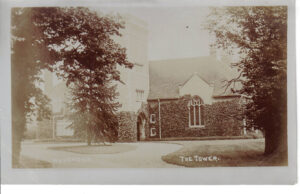
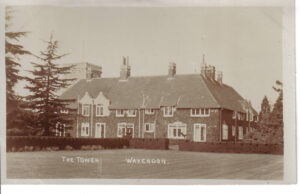
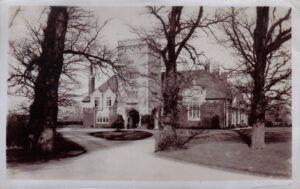
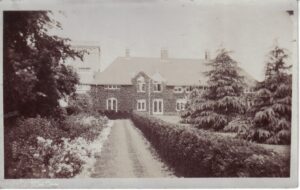
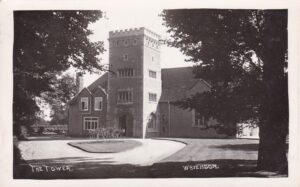
From 18th July 1913, Alexandrina Burn Skinner began to advertise for staff – cooks and maids etc. – for Wavendon Tower. At the time of the 1911 census she had been living with two of her daughters, Dorothy and Ina, in Harrow. She was the widow of a stockbroker, the late John Skinner “…of Calcutta”. The latter information appears in several notices when a third daughter, Innes Muriel, (born 1881 in Paris) got married a year later. The Bedfordshire Times & Independent of Friday 31st July 1914 reported on the festivities:
“WAVENDON WEDDING: SKINNER-CROSSLEY. Never in the memory of the oldest inhabitant has Wavendon seen such day as Wednesday. It was made a general fete through the generosity of Mrs. Skinner, of the Towers, in honour of the wedding of her daughter, Muriel, with Mr. Leonard Crossley, of London. The Day School was closed, and after the ceremony, which took place at 11.45 a.m., the day was given to enjoyment. At 2.30 the Woburn Sands Band, under Mr. H. Giles, arrived to discourse music during the afternoon, and for dancing in the evening, and at the same time a cricket match, Married v. Single, was commenced in the Recreation ground, swings being hung on the trees for the youngsters. In a large marquee tea was served to the children at 4, and high tea to the adults about 5p.m., the conclusion thereof being marked by hearty cheers for Mrs. Skinner. During the adult repast, the youngsters were racing tor prizes and scrambles for sweets followed. Later they were regaled with mineral waters, and the adults with a stronger beverage if they so desired. Dancing concluded the program, and the weather being fine, a most happy day was spent, and one which will linger long in every memory.
Strings of flags and other decorations were hung in many places across or beside the road from the Tower to the Church, and some time before the hour fixed for the ceremony the sacred edifice was filled. The stall rails were decked with choice ferns, palms, and arum lilies, and ferns and flowers also beautified an already charming vista to the altar. From the church porch to the road, the path was carpeted. and an awning covered in the whole. As the guests assembled. Mr. Buxton, the organist, played with sweet effect, a Fanfare (by Jude), and the Bridal March from Lohengrin. The service was fully choral including the hymns, “O perfect love” and “Love divine, all love excelling,” and at the conclusion of the formalities in the vestry, and the recession of the happy pair, Mendelssohn’s Wedding March sounded forth, while directly after came a peal from the belfry, the prelude to several before evening closed in.
The bride’s dress was of white satin and Limerick lace, the gift of her mother. She wore a string pearls, the gift of her mother, and a diamond brooch from the bridegroom, and carried a choice white rose shower bouquet. The bridesmaids were Miss Ina Skinner, Miss Mary Skinner, and Mary K. Swaine, and they wore apricot taffetas ninon and lace dresses, black velvet and lace hats, enamel and opal brooches, and carried pink rose bouquets. The brides mothers dress was black satin crepe. Mr. Oswald Skinner, the bride’s brother, gave his sister away, and the best man was Dr. Falconer. The Rev. G. W. Warmington officiated at the service.”
There then followed a half-column list of all the wedding presents they had received. They left for a honeymooning motor tour. There are very few mentions of the Tower during the First World War – Mrs. Skinner gave £5 to the North Bucks Joint Fund collection by the Red Cross in 1916 and 1918 and occasionally advertised for more domestic staff. She allowed the tennis court to be used for a local competition in 1922.
Henry Edward Burney was still living in Brighton at the time of his death in September 1924, although he was buried at Wavendon. He left £5241 in his will. Two cottages and an enclosure of old pasture, known as Church Close that he still owned in Wavendon, were sold in May 1926. Ortensia Burney died in October 1928. A trust had been set up to manage the Tower Estate, alongside their son, Guy.
In 1928, Mrs. Skinner organised a concert at the Wavendon Endowed School, where her daughter, Judy, sung soprano alongside a group of visiting Russian musicians.
With her daughters elsewhere, Alexandrina was living in the Tower alone with her staff at the 1921 census. She was 70-years-old, born in Dunbar and gave her occupation as ‘Home Duties’. She had a Parlourmaid, a Housemaid and a wonderfully-titled Betweenmaid.
She had also had a son, Oswald Charles. He died in March 1930 in Nairobi, while Secretary of the Muthaiga Country Club, but his will gives Wavendon Tower as his residence. He appears in the Register of Electors as living there 1926-29. His sisters Ina and Dorothy are listed there 1929-31. The last entry of the Register of Electors showing Mrs. Alexandrina Skinner living at the Tower herself is in 1931. She died at Burghope Winsley, Wiltshire in August 1935, leaving £24,000 in her Will. I cannot find any trace of her death being mentioned under any Wavendon news reports, but the Northants Mercury mentioned her Will.
Wavendon Tower was sold the next year by Guy Burney and trustees of his fathers’ estate. Guy eventually died in 1941, having just moved back to Wavendon from London, to get away from the Blitz.
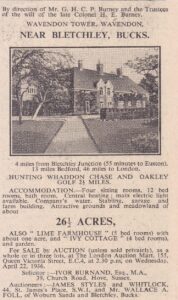
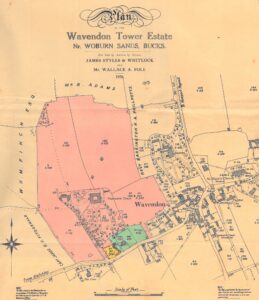
The Marler Family, 1936-1955
The new owner was Leslie Sydney Marler, chairman of Marler Estates Ltd., a successful London estate agency.
In 1932, his family had been living at Heatherley, St. George’s Avenue, Chertsey. The Tower had not sold the first time it was put up. From the Bedfordshire Times & Independent of Friday 30th October 1936:
“WAVENDON TOWER ESTATE Residence of late Mrs. Skinner. Sold to London Man. The Wavendon Tower Estate, which was bought in at auction last April, has now been sold through the agency Mr. Wallace A. Foll, of Woburn Sands, and Messrs. James Styles and Whitlock, of London, to Mr. L. Sydney Marler, of London. The residence was erected in 1890 for the occupation of the late Colonel H. E. Burney and was until two years ago the home of the late Mrs. Skinner. It has a stone-built tower in the Tudor style and is arranged in the form of hollow square enclosing a lawn. There are four acres of gardens. The estate extends to about twenty-eight acres. It is understood that Mr. Marler will be coming into occupation at the residence.”
Mr. Marler quickly embedded himself in Wavendon life, becoming Chair of both the village cricket and football clubs and becoming President of the local British Legion. He also served as the Honorary Treasurer for parish church finances. He took on the shooting rights at Caldecote and, at some point, also took control of local Fen Farm and Glebe Farm in the village. Presumably, it was at one of these farms that he set up his herd of shorthorn cattle.
He also arranged for a boxer, Norman Snow, the Southern Area Welterweight champion, to come to the village to train local boys. The story was picked up by the Daily Mirror, who published an article under the headline “Makes Village Fight-Mad”, in January 1939, in which they suggested they had interviewed Mr. Marler. In fact, they had not spoken to him directly at all, and after High Court action, the Mirror had to pay his costs and print a retraction and apology in June!
![Daily Mirror articles, January & June 1939 [British Newspaper Archives]](https://www.mkheritage.org.uk/wsc/wp-content/uploads/sites/17/2025/10/1939a-195x300.jpg)
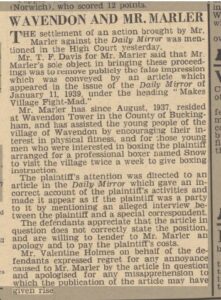
At the start of the Second World War, a national register was taken of all residents in the country. The entries for anyone possibly still alive remain blanked out of the register today. For Wavendon Tower, Leslie is listed as 39 years old, a “Director of Property Companies and Surveyor”. Doris, his wife, was a year younger. Also present are Eric Marler (Leslie’s brother – an estate agent and with the Royal Air Force Volunteer Reserve), Lila Alexander (Cook) and Freda Wooding (Kitchen Maid). A line is then blanked out so it is hard to tell if it relates to the same property or not, but then Mary Gooding (House Parlour Maid) appears, so the entries are very likely to continue to be for the Tower, followed by a Frederick Norman (University Professor – Temporary Civil Servant) and Arthur T. Hatto (University Lecturer – Temporary Civil Servant). These names give a clue as to why there is almost no mention of the Towers again in the papers for the duration of the War – they were staff working at Bletchley Park.
![Prof. "Bimbo" Norman. [Courtesy of Bletchley Park Trust]](https://www.mkheritage.org.uk/wsc/wp-content/uploads/sites/17/2025/10/Bimbo-Norman-240x300.jpg)
Professor Frederick “Bimbo” Norman was also at Bletchley Park 1939-45, working in Hut 3 and Block D(3), Hut 3 watch and later the Research Section, which specialised in providing scientific intelligence to the Air Ministry’s Assistant Director of Intelligence (Science), R. V. Jones. He was a Lecturer and Reader in German at University College London, University of Reading and King’s College London 1922-37, then Professor of German at King’s 1937-65.
But the building played its part as much as its residents. Wavendon Tower was used during the war as a recording studio for ‘Black’ propaganda. From Wikipedia:
“Gustav Siegfried Eins (GS1) was a British black propaganda radio station during World War II operated by the Political Warfare Executive (PWE). It was the brainchild of Sefton Delmer, a former BBC German service announcer recruited by PWE in 1940, and claimed to be an illegal radio station operating within Nazi Germany. The callsign was based on the German Army phonetic alphabet for the letters GS, but had no meaning. The programmes were recorded on glass disc at the Wavendon Tower studio then taken to the short-wave radio stations at Signal Hill, Gawcott and Potsgrove.
The broadcaster was Peter Seckelmann, a refugee from Berlin, who used the name “Der Chef” and claimed to be a proud, highly patriotic Prussian officer of the old school, totally loyal to Germany. In the first Gustav Siegfried Eins broadcast, immediately after the flight of Rudolf Hess to Scotland, “Der Chef” ranted that “As soon as there is a crisis, Hess packs himself a white flag and flies off to throw himself and us on the mercy of that flat-footed b****rd of a drunken old cigar-smoking Jew, Churchill!”
Most of “Der Chef’s” diatribes were directed against low- and middle-ranking Nazi Party officials, the so-called Partei Kommune, which he portrayed as selfish, corrupt and sexually depraved gangsters whose behaviour shamefully contrasted with ‘the devotion to duty shown by our brave troops freezing to death in Russia’.
The first broadcast was on the evening of 23 May 1941 and the final broadcast in late October 1943.[2] The scripting ostensibly had the Gestapo storm the station and shoot Der Chef. Unfortunately, the recording engineer who played the transcription did not understand German, and played the “death” of Der Chef twice. The station was replaced by Soldatensender Calais.”
The Tower was even given its own codename – “Simpson”. Many other large, secluded buildings in the local villages were also utilised for secret war work, including Wavendon House (where the floors of an outbuilding had to be strengthened to hold the weight of code-breaking machines), Paris House and Marylands in Woburn and several in Aspley Guise.
The Allies were innovators of black propaganda broadcasts – creating fake radio stations which transmitted over enemy territory. Recordings of material were initially made at Whaddon Hall before a larger base was sought. Ralph Murray, a former BBC European correspondent and now with the Political Warfare Executive, was in charge of the four studios created in the house, including one in the former billiard room. Foreign exiles would rehearse their scripts, then record the programmes onto 16-inch glass discs at Wavendon Tower, before these were taken to transmitters to be played over to Germany etc. Some recordings were in low-level code that was designed to be broken by the Nazis and therefore filled with irrelevant or misleading information, whilst others were supposedly ‘proper’ radio stations, but gave out negative or undermining political news. Music was added to the recordings for authenticity but they later switched to more live-to-air programmes when supplies of the discs began to dry up, due to mounting shipping losses of imports coming in from America.
John Taylor’s book, “Secret Sisters”, (to which readers are directed for a full account of how the local area helped in the psychological front of the war) gives a fascinating account of these top-secret activities:
“[At Wavendon Tower] …several studios were set up and shuttered and curtained; one would be in the billiards room where, beneath the novel introduction of fluorescent lights, three chrome-plated R.C.A. microphones awaited use, one suspended from the ceiling, one on a stand and the other one mounted on a desk. Later the billiard room would find use as a waiting room for those broadcasters waiting to speak, but, compromising the secrecy, the walls were not soundproofed. Occasionally this then led to rather unfortunate incidents when one team, representing a particular political position, could hear the broadcasts of another, representing a different political view!”
On 19th November 1941, the King and Queen visited Woburn Abbey. The Queen’s brother, David Boyes-Lyon, was a member of the Political Warfare Executive and had recorded a presentation on the work being done with radio for their Majesties, almost certainly done at Wavendon Tower. Here is a snippet of it:
The programme for the day started with arrival at 12.45 at the London Gate in Woburn and they spent an hour at Paris House before moving to Woburn Abbey where he met the PWE Heads of the various departments concerned. Even the King’s diary entry for that day was suitably vague about what the visit was for:
“We visited the H.Q. of the Political Warfare Executive, which is not housed in London. Three departments are interested in its activities, the F.O., M.E.W. & M.O.I. The three Services coordinate their working needs through the Minister of Defence’s people. Mr Leeper is head of it, a F.O. man, & he has sub heads of sections under him. David Lyon is in charge of the administration part of it and co-ordinates the various sections one with another. It was a foggy day so we could not see the beauty of the house or the park in which they live…”
Several other important political figures and dignitaries from Britain’s allies were also shown around the studios, including Anthony Eden in June and then a party of American military leaders in July, 1942. By 1943, there were 23 fake radio stations being recorded and broadcast. The studio was also used for copying material. In November 1942, a speech by President Roosevelt about the landings in North Africa arrived in Britain on smaller discs, unsuitable for British machines, so they were taken to Wavendon to be copied onto the standard discs for transmission.
All of this work was done under the strictest of security. New staff were given a warning by a security officer and issued a pass. They were then not allowed to communicate anything about the project with anyone who could not produce a matching pass.
![The square building of the Tower is middle-left, with the long driveway in front of it, on this aerial view taken May 1947. [Historic England collection]](https://www.mkheritage.org.uk/wsc/wp-content/uploads/sites/17/2025/10/Wav-Tower-Aerial-300x185.jpg)
Leslie Marler was heavily involved with the local Conservative party. In 1946, he stood for the Woburn Sands Division in the County Council elections against a Labour candidate of a retired LMS Bletchley Station chief clerk. He was also Chairman of the Buckingham Division of the Conservation Association, occasionally writing to the newspapers to get his political points across.
One of the housemaids at the Tower after the war was Margaret Jackson, whose memories were used in a book called “Tales of the Old Villagers”, in 1997. She recalled:
“They were very agreeable people, estate agents, and I was happy there for eleven years, until the family moved away. The only hard work I had to do was endlessly washing pairs of breeches because Major Marler and his elder son used to go out hunting with the North Bucks Beagles so much, often two or three times a week.”
In 1948, the Marler’s only daughter, June, was married, to a Captain Arthur John Fenwick Micklem of Whitchurch – her photo appearing in the 25th August issue of Tatler.
![June Marler in Tatler 1948 [BNA]](https://www.mkheritage.org.uk/wsc/wp-content/uploads/sites/17/2025/10/June-Marlerb-1-234x300.jpg)
In 1955, the Marler’s left Wavendon and Wavendon Tower was put up for sale. They moved to Whitchurch, near their daughters in-laws, to live at Bolebec House. Leslie Marler was awarded an O.B.E in the 1957 New Years Honours List for political and public services in Buckinghamshire and became Sheriff of Buckinghamshire for 1971-72. He died in April 1981.
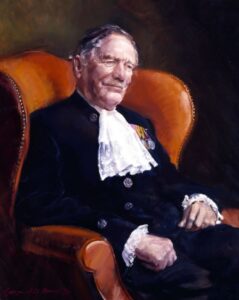
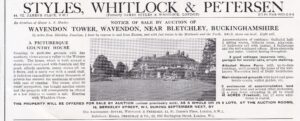
Buckinghamshire Archives hold a copy of the sale particulars, describing “Wavendon Tower (residence with around 41 acres), Mortimer Cottage, 5 and 7 Walton Road, Wavendon, with photographs and plan, Sep. 1955”. [D-WIG/2/11/149] The “picturesque medium-sized country residence in park-like grounds and in first-class order” are described in depth. Accommodation in the main house comprised of the Galleried Hall and four sitting rooms, a Billiards Room, ten bedrooms (with basins), four bathrooms, well equipped offices, ample stabling and garages for several cars. Three nearby cottages were available in separate lots. Two fields north of the Rectory and alongside Stockwell Lane were being sold too.
Some rarer images from inside the building and the out-buildings from the 1955 Sales Brochure
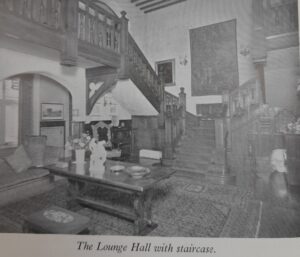
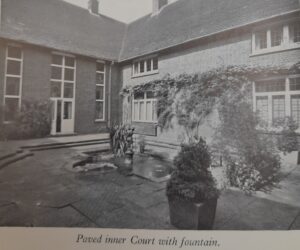
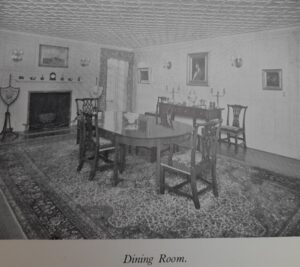
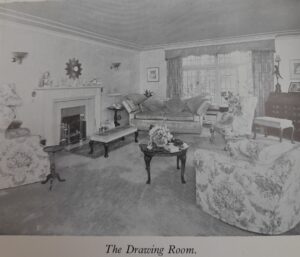
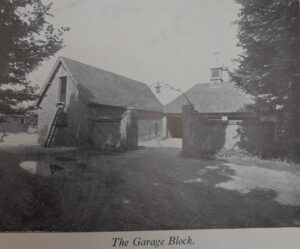
The Barker Family, 1955-1959
As local newspaper reports begin to cease concentrating on local matters, it gets harder to find news about the house and owners. I don’t know if the sale in 1955 went through successfully. A couple of sources have an Alfred W. Barker living in the house c.1956-1959, but I don’t know if he owned it or only rented it.
A local resident who visited the Tower as a child with their parents for lunch recalls Barker as the owner of Sandall Precision (hydraulic and mechanical engineers firm of Watling Street, Bletchley) and him talking about the lead cistern in the house and the need for the servants to pump up the water. Apparently, the lead had an impact on the residents and the ice house.
“I remember Alf Barker smoking a cigar and flicking the ash onto the carpet – and my overly house-proud mother bristling, and a wax disk recording device – all the toys. They moved to Sherington – to a “tiny” relatively speaking, farmhouse with a conservatory full of lathes, milling machines. He was a genius mechanical engineer…They later moved on to Jersey.”
Barker’s firm held several US Patents for their inventions. In 1969, Alfred Barker sold his firm to Westland Aircraft, to whom much of their work had been previously contracted.
The Fernberg Family, 1959-1967
Barker had certainly moved on by 1962, when Eric Birger Fernberg was in residence. He appears to have bought the Tower and the Stockwell Lane fields. He, too, was a mechanical engineer and the history of his extraordinary business career appeared in the Kensington Post, on 27th September 1963:
“Business started with £100 sold for £825,000. Demonstrating that retirement need not mean inactivity and boredom, an engineer who recently sold his business took up raising pedigree Aberdeen Angus stock and has in a short time won several first-class prizes. Mr. Eric Fernberg came to England as a young man with a family, from Sweden. After working for several firms as an engineer and designer, he formed a company in partnership with a friend, Mr. Tolhurst, in 1935 with a capital of £100. The company had no factory, and used a room in Mr. Tolhurst’s house as an office. Mr. Fernberg had then designed a clip for securing the panels on to the doors of cars. The firm offered them to a leading motor company at 1s. 1d. for 144 compared with 3s. 9d. a hundred which the company was then paying and immediately got an order for two million. The clips were made for them by a firm in Park Royal.
SEVEN FACTORIES. “I designed the clip,” said Mr. Fernberg, “so that it would do the job and also so that it could be made in one operation. This was very important, for it was a major factor in keeping down costs.” The next step was to design the tools to ensure that the clips were made precisely to his specifications. Mr. Tolhurst had taken over the sales side while Mr. Fernberg was mainly concerned with design and production.
Orders continued to come in until they had seven factories working them. “We had to make all the samples by hand and this often proved very difficult, for sometimes the customer wanted a gross of his order to try them out.” he said.
MORE COMPLEX. Then, as the range of clips increased and the designs became more complex, the factories found that they were unable to produce certain types. The firm had to decide whether to drop a clip from the range altogether or set up a factory of their own. In 1945 the firm rented a derelict factory in Uxbridge, Middlesex. A machine was installed with three operators. Ten years later the firm had a new factory built, costing nearly £70,000. Meanwhile to ensure that the clips were made efficiently Mr. Fernberg designed the machine as well as the tools with the result that the machines were further improved and capable of producing 500 clips a minute.
PRIZEWINNERS. At the beginning of this year he severed his links with the firm when the concern which was started with a capital of £100 in 1935, was sold for £825,000 cash. Of this Mr. Fernberg’s share was £400,000. He then directed all his attention to an Aberdeen Angus herd, which he had bought three years ago. In July of this year he caused a stir among the pedigree Aberdeen Angus breeders when, unknown, he carried off two first prizes, two seconds, the breed championship and two special awards at the Peterborough Show.”
F.T. Products, as his firm had been called, had made £225,000 in 1959 and also had a factory at Aylesbury. They were bought out by the United Carr Fastening Corp., of Boston, USA. Whilst his bulls were winning prizes, the other animals in his life were proving less popular in some quarters… From the Luton News & Bedfordshire Chronicle, 17th May 1962:
“Pretty Tails and Weird Cries. The pretty Bucks village of Wavendon, near Woburn Sands, has been split into two camps – by peacocks. Half the village wants the owner, wealthy engineering company chairman, Mr. Eric Fernberg, to keep them locked up on his estate Wavendon Tower. The other half say the birds are an attractive sight for visitors and should be allowed to roam the village. After receiving a petition signed by 11 villagers, Mr. Fernberg has decided to offer them to “a charitable organisation.” Mr. Fernberg bought the two peacocks a few years ago from Bedford Zoo. As they became used to their new surroundings, they wandered among the centuries-old cottages in Wavendon and perched on roofs and garden walls. But recently they have been blamed for scratching up flower and vegetable plots. The petition demanded that Mr. Fernberg keep them under control.
ATTRACTIVE CREATURES. Mr. John Watson, a local artist, who organised the petition, said “They are attractive creatures, but unfortunately a nuisance.” Mrs. Fernberg replies, “There are lot of nosy people in Wavendon making trouble. It is only the peacocks’ morning and evening song that troubles them, they don’t eat plants, only insects, they sit on walls and roofs but are no bother.” Recently the birds brought the church service almost to a stop when they made their cries in the church porch. This week Mr. Fernberg wrote to all the petitioners telling them he was disposing of the birds “with great regret.”
He served on the committee for the new Wavendon Primary School and Community Centre as Vice President before it opened in July 1965. Eric won more prizes for his cattle, including the Aberdeen Angus supreme champion prize at the Oxford Show in May 1965 with his heifer ‘Wavendon Beth Maid’. From January 1966, he and his wife went on a five-month Five Continents cruise on Cunard’s RMS Caronia.
Six months after returning, Eric died at Stoke Mandeville Hospital, aged 67, just three years into his retirement. The cattle show reports of the next year commented on his sad loss and that his herd was being dispersed. His widow put the Tower up for sale on the open market with Brown & Merry, the plan of which survives at Bedfordshire Archives (X395/61). This shows there were now more fields with the estate – those east of Stockwell Lane and some the other side of Newport Road too – as well as the houses just east of St. Marys and no.6 Theydon Avenue in Woburn Sands.
But it wasn’t another wealthy individual who bought it, it was an entire Government-backed body looking for a headquarters. And thus, after just four private owners spanning 77 years, the Tower passed out of private individual hands and into the world of Government and business, for the price of £35,500.
![A ‘Polaroid Land Camera’ photo of the front of the Tower, as it was when sold in 1967 [Bucks Archives]](https://www.mkheritage.org.uk/wsc/wp-content/uploads/sites/17/2025/10/20231005_100741-300x225.jpg)
Milton Keynes Development Corporation, 1967-1984
From Wikipedia:
“Milton Keynes Development Corporation (MKDC) was a development corporation operating from 1967 to 1992 oversee the planning and early development of Milton Keynes, then a planned new town midway between London and Birmingham. MKDC was established on 23 January 1967 to provide the vision and execution of a “new city” that would be the modern interpretation of the garden city movement concepts first expressed by Ebenezer Howard 60 years earlier.
Situated in the north of Buckinghamshire near the borders with Northamptonshire and Bedfordshire, it would be a “city in the trees” – the planning guideline for residential areas outside Central Milton Keynes was “no building higher than the highest tree” – at a time when multi-storey flats and office blocks were dominating the redevelopment of most inner-city areas and many large towns.”
MKDC had been operating from London up to this point. They had been courted by the Stony Stratford Chamber of Trade to have their headquarters in the High Street there, but decided it did not have the enough space to expand. Some staff had started working nearby at Walton Hall which later became the Open University.
A proposed layout plan (July 1967) of Wavendon Tower shows that Lord Campbell, head of the Corporation, was to have the tower room over the doorway, but other correspondence shows he refused it as ‘unsuitable’. The same month, MKDC minutes record:
“Purchase of Wavendon Tower for £21,500, 28 acres of associated land for £10,500, and a semi-detached dwelling for £3,500 has been agreed following valuation by the District Valuer. Legal occupation is expected by the end of July and the auction of furniture will take place on August 2nd. Some alterations, decorations and re-wiring will be required and it is hoped that those required for early occupation can be completed during August. The Secretary is already residing unofficially and it should be possible to announce formal establishment of the headquarters at Wavendon by the middle of August… Extensions to the buildings will be required to receive incoming staff in 1968, and suitable arrangements are being examined with the help of the County Architect’s Department.”
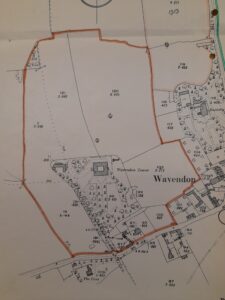
The sale of contents actually took place on 1st August. A comprehensive catalogue was printed, [D-MKDC/11/1/1/17] listing 443 lots. These included, among the more mundane household items, a Bendix ‘Gyramatic’ washing machine, the full-size walnut Billiard table, two dinghies, all the kitchenware and crockery, a 1913 bottle of Hennessy brandy and several lots of cigars! Sadly, there was much recrimination afterwards when it was found that a lot sold as ‘gates’ were actually an important part of the pigsty fencing and were supposed to have been retained.
Plans to build on such a huge scale required hundreds of specialist staff, all working in close cooperation with each other. With no ready-made office accommodation large enough in the old towns and villages that would fall under Milton Keynes at that time, the house seems to have been picked as it had grounds that could be used for temporary extra buildings as required. In actual fact, whilst the drive and some of the grounds of the house are within the original MK development-area boundary, the house itself stands a few metres outside of it. The new increased use of the building wasn’t without problems – mystery cracks appeared in the Wavendon Tower brickwork and some MKDC staff had had to be temporarily evacuated, according to the Beds & Bucks Reporter of 3rd November 1970.
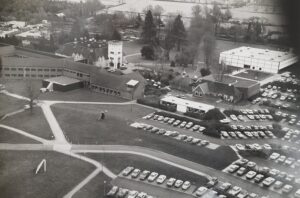
Bucks Archives holds many MKDC records, not only about the new town they were creating, but also about their own office building, grounds and the working lives of the staff based there. A licensed club, with bar, lounge, snooker room and squash court was opened in the old stable block for staff to socialise in. The famous MK grid-road layout, the names of estates and other defining features of the new town (now City) of Milton Keynes were all planned from Wavendon Tower. It had some high-profile visitors over the years, including HRH the Duchess of Kent in 1976. Denis Mynard wrote an article on Wavendon Tower in the MKDC staff magazine The Insider in October 1981.
A large, multi-winged extension was made to the north of the building to house more staff as the Corporation grew. Several space-age new prototype buildings appeared in the grounds, including some Plastic-Balloon Instant Offices in February 1971. It even had its own helicopter pad, from where Prince Charles departed Milton Keynes after a visit in May 1982. At some point, a new access road (called Ortensia Avenue, after Henry Burney’s wife) was put in from the new Milton Keynes grid road, Groveway, at the rear, meaning the original gateway on Walton Road was stopped-up.
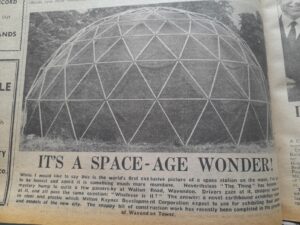
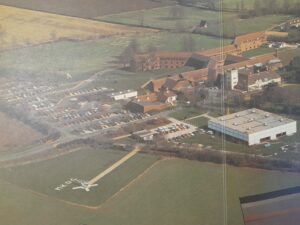
In July 1984, with Central Milton Keynes now established and more modern office accommodation available, the Development Corporation moved to Saxon Court. They put together a brochure [D-MKDC/11/9/1] for selling the Wavendon Tower estate:
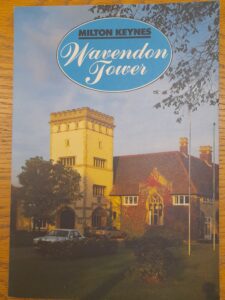
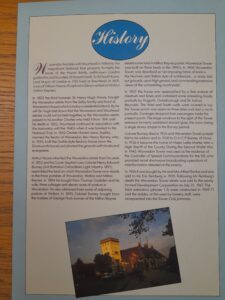
The addition buildings erected by MKDC had given it a total area of 105,000 ft2. There was a 120-seat conference suite and a staff canteen capable of providing 250 meals a day. The rateable value was £63,722 and fuel costs of between £75-85,000 annually. Gas mains had not yet reached the estate but were expected in the next couple of years. Therefore, Wavendon Tower was sold to Scicon Ltd. for c.£4.25m.
Business Estate 1984- Present
Scicon Ltd were originally the IT-arm of the international oil company BP and had been using premises in Kiln Farm, Milton Keynes before taking Wavendon Tower. They were advertising their ‘prestigious’ new offices at Wavendon Tower by September 1984 and news reports said it would create 400 new jobs. They provided ‘manufacturing management systems’ in the computer services industry and Wavendon was to be the hub for development of new systems. The opening of their new facility coincided with their Silver Jubilee and the Duke of Edinburgh visited the site to perform the official opening in 1985 and he apparently commented on the peacefulness of the surroundings.
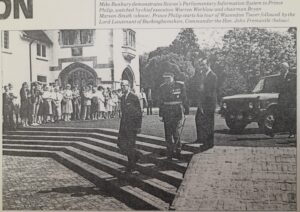
After an initial change of hands which saw the owners become SD Scicon, they were bought out by EDS in 1991 and the site evolved into a business park for EDS as a single occupier in 2005-6. The old extension wings were demolished to provide space for three separate modern buildings, named after Bletchley Park equipment. [See film at https://www.youtube.com/watch?v=9JKBr9pjZKM&ab_channel=sciconconnect ]
There was much concern in the village about traffic in 1996, as the number of staff working onsite were set to grow from 485 to 1600. EDS were later taken over by Hewlett Packard. The Wavendon Tower site subsequently evolved into a multi-tenanted business park for a range of corporate occupiers and was known as “Wavendon Business Park”. In 2019, Unisys joined the tenants which already included global security services provider Securitas, US aerospace giant Boeing and IT group DXC.
Colmore Capital bought the business park in 2020 and rebranded it as “The Park MK”:
“With emphasis on community, workplace wellbeing and considerable attention given to the landscaping, the site has become a sought-after green environment for corporate life. Attracting a wide variety of occupiers, it is now (2023) home to national and international companies: Securitas, Boeing Defence, Unisys, Renewi, FCA, Spectrum Control and Pluxee.”
As well as providing the name of Ortensia Drive, there is also a Burney Drive through the new development east of old Wavendon village. The name given to the commercial area developed north of the house is ‘Towergate’.
My grateful thanks to the following for providing assistance in this project:
- Buckinghamshire Archives
- Hoare & Co. Bank Archives – Pamela Hunter
- Local Historian & author John Taylor
- Windsor Castle Royal Archives – Julie Crocker
- Historic England aerial photo collection
- The Park MK Wavendon site manager – Sarah Osoba
- Garry Tomlins
Page last updated Oct. 2025.
